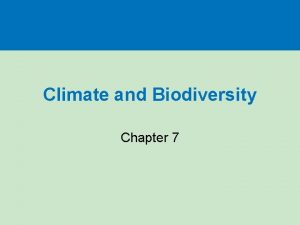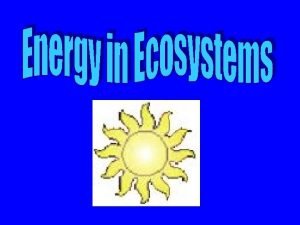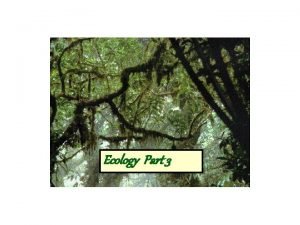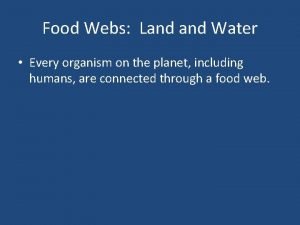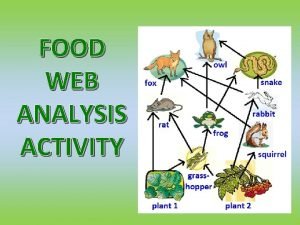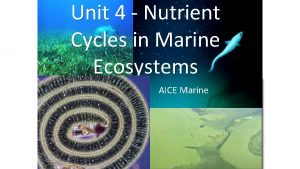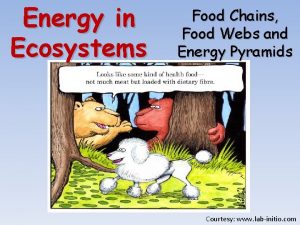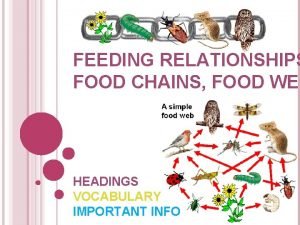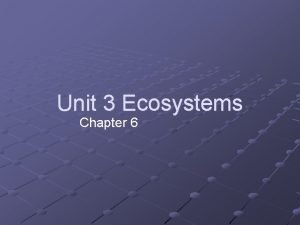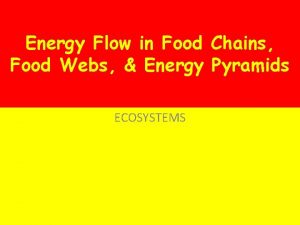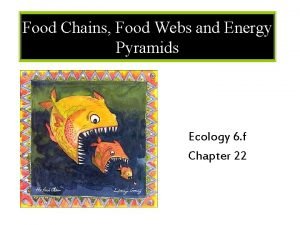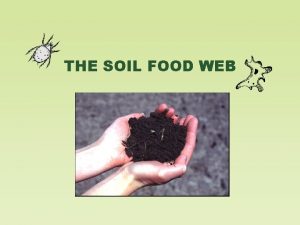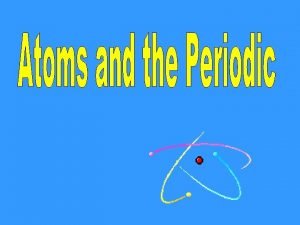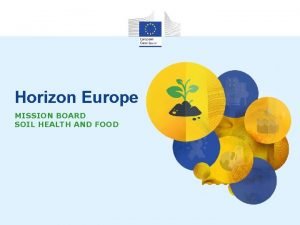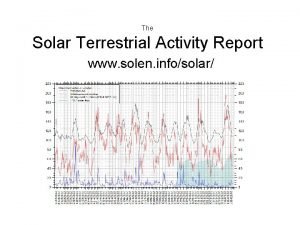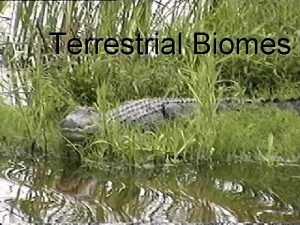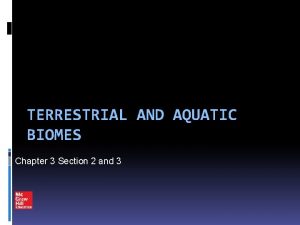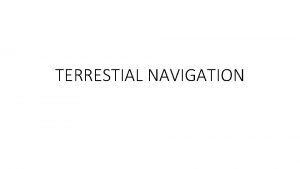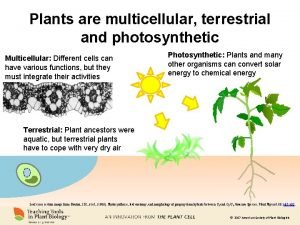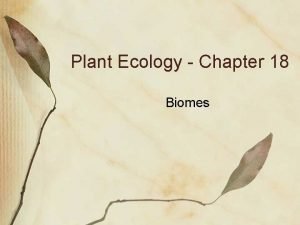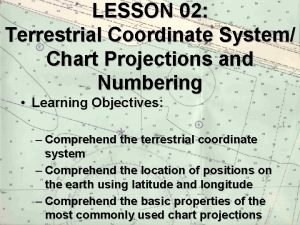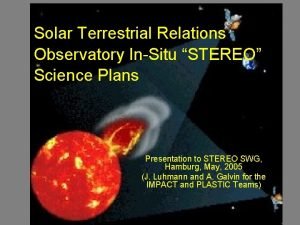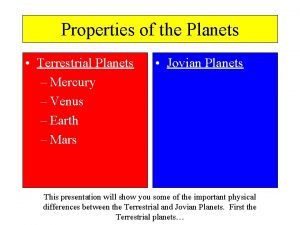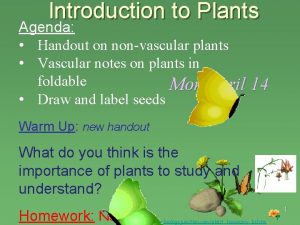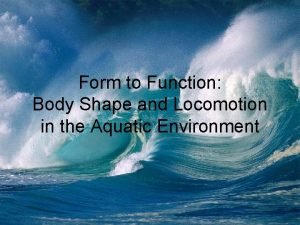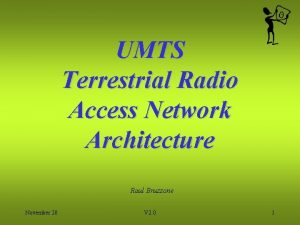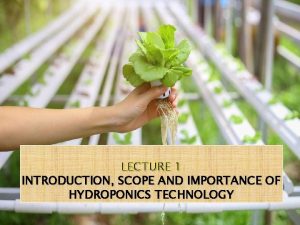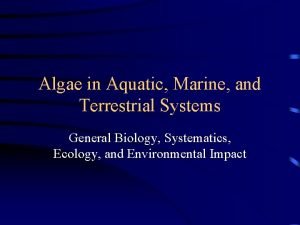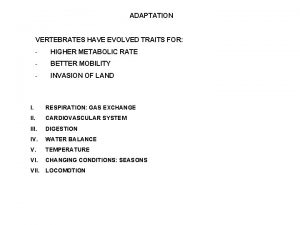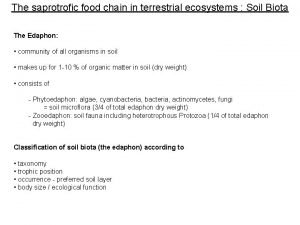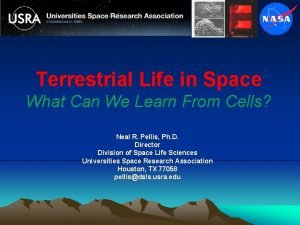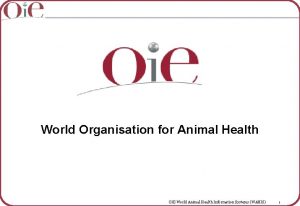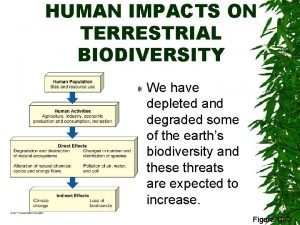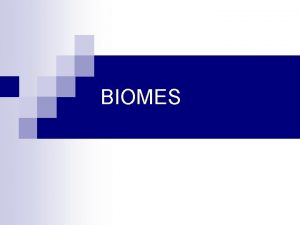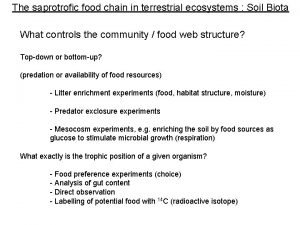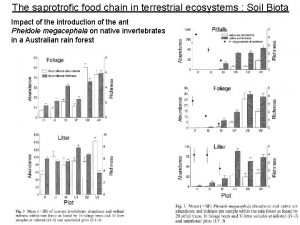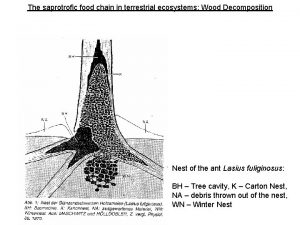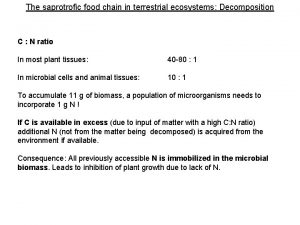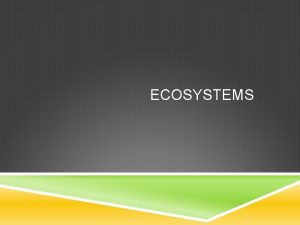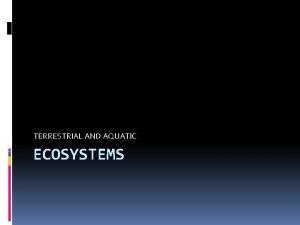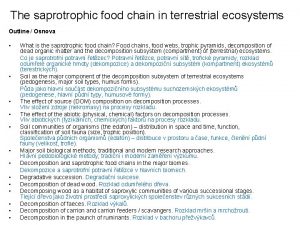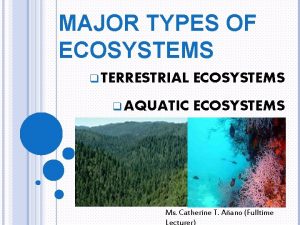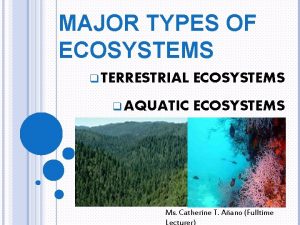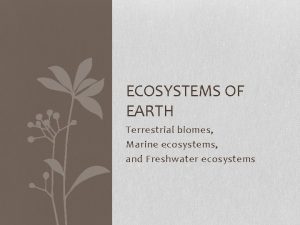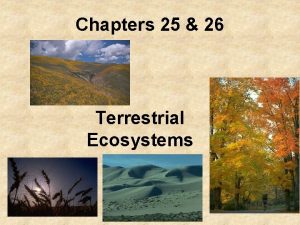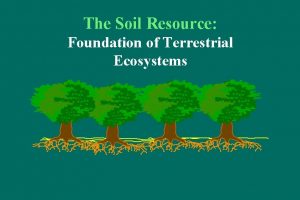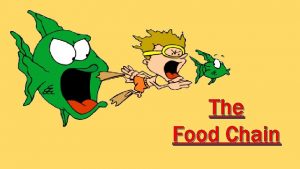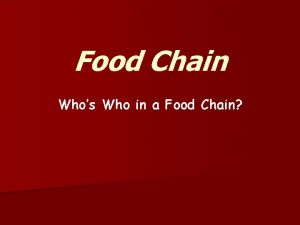The saprotrofic food chain in terrestrial ecosystems Soil

































































































- Slides: 97

The saprotrofic food chain in terrestrial ecosystems : Soil Biota The Edaphon: • community of all organisms in soil • makes up for 1 -10 % of organic matter in soil (dry weight) • consists of - Phytoedaphon: algae, cyanobacteria, actinomycetes, fungi = soil microflora (3/4 of total edaphon dry weight) - Zooedaphon: soil fauna including heterotrophous Protozoa (1/4 of total edaphon dry weight) Classification of soil biota (the edaphon) according to • taxonomy • trophic position • occurrence - preferred soil layer • body size / ecological function

The saprotrofic food chain in terrestrial ecosystems : Soil Biota Classification of soil biota (the edaphon) according to • taxonomy • trophic position • occurrence - preferred soil layer • body size / ecological function Principal trophic groups: • saprophages or saprotrophs / detri(ti)vores / decomposers, reducers • includes mircobivores (fungivores + bacteriovores) • includes necrophages (carrion feeders, scavangers) • phytophages / herbivores (feeding on roots or algae) • zoophages / carnivores / predators Decomposers often synonymous to “reducers“ (decomposition processes more often oxidative than reductive), destruents (Czech: rozkladači, decompozitoři / reducenti, destruenti) Reducers sensu stricto: organisms mineralizing organic matter (fungi, bacteria), do not have to be in soil.

The saprotrofic food chain in terrestrial ecosystems : Soil Biota Classification of soil biota (the edaphon) according to • taxonomy • trophic position • occurrence - preferred soil layer • body size / ecological function Groups according to preferred soil layer: • Euedaphon: - permanently living in soil, geobionts (Pelikán) - in deeper soil layers (Schaefer) • Hemiedaphon: - occassionally in soil (Pelikán) - in the uppermost mineral soil layer and litter layer (Schaefer) • Protoedaphon: - only some developmental stages in soil, geophiles (Pelikán) • Pseudoedaphon: - occassionally in soil: refuges, hibernation, foraging (Pelikán) • Tychoedaphon: - accidental occurrence in soil (Pelikán) • Epigeon (egigaion, epigeic animals): directly on the soil surface (vs. hypergaion in the vegetation, sometimes synonymus to atmobios)

The saprotrofic food chain in terrestrial ecosystems : Soil Biota Classification according to body size into micro-, meso-, macrofauna (sometimes additionally megafauna) – two alternative approaches based on body length and body width

The saprotrofic food chain in terrestrial ecosystems : Soil Biota Vertical distribution of soil animals (according to soil depth in cm) - Figure shows soil arthropods only

The saprotrofic food chain in terrestrial ecosystems : Soil Biota Vertical distribution of soil animals s. l. in a beech forest with mull humus

The saprotrofic food chain in terrestrial ecosystems : Soil Biota Horizontal distribution of soil animals Example: Isotomurus palustris (Collembola) – each individual shown as a dot; Trogophloeus pusillus (Coleoptera: Staphylinidae) -each individual given as a x) on a 1 square meter plot. The two distributions are independent from each other.

The saprotrofic food chain in terrestrial ecosystems : Soil Biota Spatial distribution of earthworm species in a forest and pasture land: species show different preference for macro- (woodland vs grassland) and microhabitat.

The saprotrofic food chain in terrestrial ecosystems : Soil Biota Effect of earthworm populations and soil erosion: annual surface erosion / annual run off) Mineral N and exchangable cations (ppm) In soil and earthworm casts Effect of adding earthworms (10 000 ind/ha) on meadow productivity in drained polders, Holland.

The saprotrofic food chain in terrestrial ecosystems : Soil Biota Live forms of earthworms and their selected ecological traits - Epigeic - Endogeic - Anecic / Anectic (anecique) Quiescence: inhibition of development (in any phase of the ontogenesis) directly dependent on environmental factors. Diapause: inhibition of development (in any phase of the ontogenesis) triggered either by environmental or endogenous factors.

The saprotrofic food chain in terrestrial ecosystems : Soil Biota Digging in of an earthworm: a) Anterior segments contracted, widening burrow b) Moving body forward (ring mucles contracted, longitudinal mucles relaxed) Allolobophora chlorotica laying an egg cocoon

The saprotrofic food chain in terrestrial ecosystems : Soil Biota

„Oligochaeta“: Enchytraeidae Cernosvitoviella minor

The saprotrofic food chain in terrestrial ecosystems : Soil Spatial distribution of enchytraeids in different biotopes

The saprotrofic food chain in terrestrial ecosystems : Soil Biota Centipede (Chilopoda) assemblages in Central European macro- and microhabitats Open Landscape: heath, mire, meadow, arable field Forest Floor Dead Wood (trunks, logs)

The saprotrofic food chain in terrestrial ecosystems : Soil Biota Selected arthropods in the litter layer of three successional stages in a In-land dune landscape Column 1: species Column 2: trophic requirements (s – saprophagous, P – phytophagous, z – zoophagous) Column 3: raw sand (and moss, grass species) Column 4: weak podzol; heath Column 5: weak podzol, mixed broadleaved forest dominated by oak Occurrence: + - scarse / ++ - frequent

The saprotrofic food chain in terrestrial ecosystems : Soil Biota Seasonality of soil and litter biota in a beech-wood on limestone (Göttinger Wald, Northern Germany)

The saprotrofic food chain in terrestrial ecosystems : Soil Biota Seasonally dependent activity of various insects in the litter layer of the same habitat (n = number of individuals, highest value given as 100 percent of each taxon)

The saprotrofic food chain in terrestrial ecosystems : Soil Biota

The saprotrofic food chain in terrestrial ecosystems : Soil Biota Representation of Soil Fauna in forest soils along a p. H Gradient (Central Europe) raw humus (mør) moder mull-like moder mull p. H neutral p. H acidic p. H 3. 5 – 5. 0 CEC 80 – 120 (me %) Base saturation 20 – 40 % C: N > 20 p. H 5. 0 – 7. 0 CEC 20 – 40 (me %) Base saturation 40 - 100 % C: N > 15 Acari (400 000), Collembola (80 000) Enchytraeidae (50 000) Acari Collembola, Insect larvae Myriapoda, Isopoda Lumbricidae (200), Isopoda (50) Insecta-larvae (80) Myriapoda (250) Myriapoda Insecta-larvae, Lubricidae Myriapoda (1000), Insecta-larvae (50) Lumbricidae (20) Lumbricidae, Isopoda Acari, Collembola Acari (200 000) Collembola (100 000), Enchytraeidae (20 000) Isopoda (20) Increase in Bacteria Increase in Fungi Decreasing Clay-Humus-Complex Formation Increasing

The saprotrofic food chain in terrestrial ecosystems : Soil Biota Microstructure of the organic top soil layer – high proportion of invertebrate faeces

The saprotrofic food chain in terrestrial ecosystems : Soil Biota Os falciforme Talpa europaea – European Mole Talpa caeca (Southern Europe): eyes covered by fur

The saprotrofic food chain in terrestrial ecosystems : Soil Biota Condylura cristata – Star-nose mole (North America): sensory cells concentrated in 22 diverticula of the snout

The saprotrofic food chain in terrestrial ecosystems : Soil Biota Cannomys badius – Lesser bamboo rat Notoryctes typhlops (Marsupalia) Myospalax myospalax – Siberian Zokor

The saprotrofic food chain in terrestrial ecosystems : Soil Biota tolerance deep fine soil depth grain size shallow coarse Relative tolerance of species of the North American pocket gophers (Geomyidae) to depth and grain size of soils

The saprotrofic food chain in terrestrial ecosystems : Soil Biota Golden mole burrow Nannospalax ehrenbergi – Palestine mole rat Eremitalpa granti Chrysospalax trevelyiani

The saprotrofic food chain in terrestrial ecosystems : Soil Biota Heterocephalus glaber – Naked Mole Rat

The saprotrofic food chain in terrestrial ecosystems : Soil Biota Rhineura floridiana (Amphisbaenidae) – Florida worm lizard

The saprotrofic food chain in terrestrial ecosystems : Soil Biota Blanus cinereus – Iberian worm lizard Blanus strauchi

The saprotrofic food chain in terrestrial ecosystems : Soil Biota Typhlops vermicularis Diplomethodon zarudnyi

The saprotrofic food chain in terrestrial ecosystems : Soil Biota Cross sections through the bodyies of millipedes (Diplopoda): a) Juloidea – bulldozer-type with rigid body ring, b) Polydesmoidea – wedge type with rigid body ring, c) Glomeridae – tergites moveable, volvation

The saprotrofic food chain in terrestrial ecosystems : Soil Biota Polyxenus lagurus: Threads with sperm dropplets (Sp) and thread road (F); arrows indicate direction of female led by the thread road towards the sperm dropplets. Lithobius forficatus (Chilopoda): Thread web around spermatophore, transverse threads with stopper function for the females.

The saprotrofic food chain in terrestrial ecosystems : Soil Biota Arthropod fore legs adapted to digging: a) Gryllotalpa vulgaris (Ensifera) b) Lyristes plebejus (Auchenorrhyncha) c) Scarites buparius (Coleoptera: Carabidae) d) Arenivaga investigata (Blattodea) e) Siloannea macrocerras (Araneae)

The saprotrofic food chain in terrestrial ecosystems : Soil Biota Ability of volvation in various groups of soil arthropods: a) Peudotritia ardua (walking), Phthiracarus setosellus (Oribatida) b) Cubaris sp. (Isopoda: Oniscoidea) c) Sphaerotherium sp. (Diplopoda)

The saprotrofic food chain in terrestrial ecosystems : Soil Biota Rove beetle (Staphylinidae) life forms: a) b) c) d) Anthobium minutum (epedaphic) Tachyporus obtusus (epedaphic) Othius punctulatus (hemiedaphic) Entomoculia occidentalis (euedaphic)

Tracheata = Antennata Hexapoda Myriapoda Progoneata Chilopoda Dignatha Symphyla Diplopoda 6 4 12 párů nohou; 1 pár stigmat na hlavě 8 9 Diplosegmenty Pseudoculus 1. pár končetin trupu přeměněn na čelistní nožky (maxillipedy) s drápy a jed. žlázou; embrya s vaječným zubem na 2. maxillách; specifická stavba spermií 5 Členění těla na hlavu (caput), hruď (thorax) a zadeček (abdomen); 2 hruď : 3 články, 3 páry končetin Chybí 2. pár antén (redukce); ektodermální Malpighiho trubice; Pauropoda 1 Gnathochilarium; 7 chybí 2. maxilly; pohlavní otvory v 2. článku trupu; stigmata u bází nohou Pohlavní otvory v přední části trupu; ontogenese: trávící trubice vzniká 3 v žloutku; Totální redukce mediáních očí a štěrbinovitých smyslových orgánů;

Tracheata = Antennata Hexapoda ? Myriapoda Progoneata Chilopoda Diplopoda 6 4 Dignatha Symphyla 12 párů nohou; 1 pár stigmat na hlavě 8 9 Diplosegmenty Pseudoculus 1. pár končetin trupu přeměněn na čelistní nožky (maxillipedy) s drápy a jed. žlázou; embrya s vaječným zubem na 2. maxillách; specifická stavba spermií 5 Členění těla na hlavu (caput), hruď (thorax) a zadeček (abdomen); 2 hruď : 3 články, 3 páry končetin Chybí 2. pár antén (redukce); ektodermální Malpighiho trubice; Pauropoda 1 Gnathochilarium; 7 chybí 2. maxilly; pohlavní otvory v 2. článku trupu; stigmata u bází nohou Pohlavní otvory v přední části trupu; ontogenese: trávící trubice vzniká 3 v žloutku; Totální redukce mediáních očí a štěrbinovitých smyslových orgánů;

The saprotrofic food chain in terrestrial ecosystems : Soil Biota Chilopoda – centipedes / stonožky Predators: litter layer, under stones, bark; Geophilomorpha in mineral soil layers. Autapomorphies: • 1. pair of limbs modified to maxillipedes with claws and poison gland; • embryos with egg tooth on 2 nd maxillae; • specific structure of sperm cells Notostigmophora Scutigeromorpha Pleurostigmophora Scolopendromorpha Pleurostigmophora Lithobiomorpha Last two pairs of legs Pleurostigmophora Geophilomorpha

The saprotrofic food chain in terrestrial ecosystems : Soil Biota Diplopoda – millepedes / mnohonožky Saprophages, in the litter layer, some under bark Autapomorphy: Diplosegments Polydesmus sp. Glomeris hexasticha

The saprotrofic food chain in terrestrial ecosystems : Soil Biota Pauropoda – pauropods / drobnušky Mycetophages and/or necrophages / zoophages (Collembola etc. ), Usually in the upper-most soil layer but sometimes down to 50 cm depth Moist but not water-logged soils Usually without pigments, white, some brownish. 0. 5 – 0. 7 (max. 1. 9) mm Autapomorphy: pseudoculus Pauropus huxleyi Eurypauropus ornatus (0. 8 mm) Pauropus sylvaticus (1 mm)

The saprotrofic food chain in terrestrial ecosystems : Soil Biota Symphyla – symphylans / stonoženky Feed on algae, bacteria, fungi, dead organic matter including dead animals, as well as on live plant tissues (roots) In mineral soil, litter, under stones and bark, in moss cushions All white, no eyes Up to 9 mm long Autapomorphies: • 12 pairs of legs; • 1 pair of stigmata on head Scutigerella immaculata Symphyllela vulgaris (3 mm, Sp - spinneret)

The saprotrofic food chain in terrestrial ecosystems : Soil Biota Crustacea: Malacostraca: Peracarida: Isopoda – isopods / stejnonožci Oniscoidea – wood lice / stinky a svinky Vzdušnicové plíce u suchozemského stejnonožce - svinky Porcellio scaber: A - pleopody z ventrálního pohledu (v kruhu exopodity 1. - 3. levého pleopoditu, v důsledku naplnění vzduchem je 1. - 2. expodit bílý) B - exopodit s dýchacím otvorem na vstupním poli vzdušnicové plíce vstupní pole s dýchacím otvorem

The saprotrofic food chain in terrestrial ecosystems : Soil Biota Oniscus asellus Left, upper row: pleon of Philoscia sp. in ventral view, left exopodites removed to show gills (grey). Left, lower row: Exopodite of 1 st pleopod of Armadillidium sp. with lung. Right: abdominal leg of Porcellio scaber, dorsal view; a – exopodite of 2 nd pleopod with lung; b – exopodite and endopodite (with gill function) of 3 rd pleopod; c – cross-section through 1 st pleopod in the direction indicated by arrow in a.

The saprotrofic food chain in terrestrial ecosystems : Soil Biota Crustacea: Malacostraca: Peracarida: Amphipoda – amphipods / různonožci Generally aquatic, a few species (also) in moist terrestrial habitats (litter layer), usually close to water bodies. Only difference of the most adapted species: somewhat shorter pleopods. Particularly family Talitridae, e. g. Talitrus sylvaticus (4 000 ind. /m 2 in Australian rain forest. In Central Europe Gammarus pulex can temporarily leave the water and live in near-by moist litter. Gammarus pulex Hyalella azteca

(Podkmen) Chelicerata - klepítkatci (Třída) Arachnida Řád Scorpionida - štíři Cca. 1400 druhů (0, 9 - 21 cm) Autapomorfie: • hřebínkové orgány (pectines)

(Podkmen) Chelicerata - klepítkatci (Třída) Arachnida Řád Scorpionida - štíři

(Podkmen) Chelicerata - klepítkatci Megoperculata Labellata Uropygi Amblypygi 9 Camarostom (ústní „předsíň“ se srostlými kyčlemi pedipalpů); praenymfy a 4 stádia nymfy; velké obranné žlázy; samice při páření drží zadeček samce Araneida Extrémní prodloužení 1. 11 kráčivých končetin na makadlo 12 10 8 Chelicery s jedovou žlázou; snovací bradavky a žlázy; přenos spermií pomocí pedipalpů Petiolus (zúžený 1. článek zadečku; dobře vyvinutá postcerebrální sací pumpa Subchelátní chelicery (dva články - „kapesní nůž“); mikrotubuli u spermatozoidů uspořádány ve vzorci: 9 x 2 + 3.

(Podkmen) Chelicerata - klepítkatci (Třída) Arachnida Řád Uropygi - bičovci Cca. 180 druhů (do 7, 5 cm); (sub)tropičtí Autapomorfie: • camarostom (ústní „předsíň“ se srostlými kyčlemi pedipalpů); • praenymfy a 4 stádia nymfy; • velké obranné žlázy; • samice při páření drží zadeček samce Thelyphonida Schizomida

(Podkmen) Chelicerata - klepítkatci (Třída) Arachnida Řád Amblypygi Cca. 100 druhů (10 - 45 mm); (sub)tropičtí Autapomorfie: • extrémní prodloužení 1. kráčivých končetin na makadlo

(Podkmen) Chelicerata - klepítkatci (Třída) Arachnida Řád Araneida - pavouci Cca. 34 000 druhů Autapomorfie: • chelicery s jedovou žlázou; • snovací bradavky a žlázy; • přenos spermií pomocí pedipalpů Samčí pedipalpus – přenos spermatofóru

(Podkmen) Chelicerata - klepítkatci (Třída) Arachnida Řád Araneida - pavouci Orthognatha - sklípkani Labidognatha - dvouplicní

(Podkmen) Chelicerata - klepítkatci Apulmonata Palpigradi Pseudoscorpionida Chelicery se 17 snovací žlázou; palpy: velká klepítka s jedovou žlázou, atd. Zjednodušená stavba coxosternální oblasti; totální redukce očí 14 Solifugida 18 Opilionida Acari Pedipalpy mají lepové žlázy; 22 melleoli (smysl. orgány); 23 přenos spermií pomocí 20 Cuculus; chelicer; atd. Penis resp. kladélko; přenos spermií Gnathosoma 3. párem nohou; jen mediální pár očí; atd. 21 jen 1 pár vzdušnic; 16 smrduté žlázy Šestinohá larva; Chelicery ze dvou 3 stádia nymfy 19 článků (klepítka) 2. pár nohou slouží jako makadla; pohlavní otvor posunut vpřed mezi coxy; spermatozoidy bez ocásku, s vtlakem 15 Totální redukce plicních vaků; redukce počtu očí na 2 -3 páry Ricinulei 13 Trubicovité vzdušnice; redukce přívěsku zadečku (bičík - flagellum)

(Podkmen) Chelicerata - klepítkatci (Třída) Arachnida Řád Pseudoscorpionida - štírci Cca. 3000 druhů (1 -7 mm); v listovém opadu, pod kůrou atd. Autapomorfie: • chelicery se snovací žlázou; • palpy: velká klepítka s jedovou žlázou, • atd.

(Podkmen) Chelicerata - klepítkatci (Třída) Arachnida Řád Solifugida - solifugy Cca. 900 druhů (1 -7 cm); pouště, polopouště, step Autapomorfie: • pedipalpy mají lepové žlázy; • malleoli (smyslové orgány); • přenos spermií pomocí chelicer; • atd.

(Podkmen) Chelicerata - klepítkatci (Třída) Arachnida Řád Opilionida - sekáči Cca. 4000 druhů Autapomorfie: • penis resp. kladélko; • jen mediální pár očí; • jen 1 pár vzdušnic; • smrduté žlázy.

(Podkmen) Chelicerata - klepítkatci (Třída) Arachnida Řád Ricinulei Cca. 40 druhů (do 10 mm) v listovém opadu tropických lesů (Amerika, Afrika) Autapomorfie: • cuculus (pohyblivý výrůstek na hřebetu prosoma; v klidu kryje ústní ústrojí) • přenos spermií 3. párem nohou; • atd.

(Podkmen) Chelicerata - klepítkatci Pantopoda Xiphosura Scorpionida 4 Euchelicerata Arachnida Lipoctena Megoperculata Labellata Uropygi Amblypygi Araneida 9 11 12 Apulmonata Totální redukce plicních vaků; redukce počtu očí na 2 -3 páry Nečleněné, 10 srostlé mesosoma; 13 2 chilaria Proboscis; 8 Subchelátní chelicery („kapesní nůž“); redukované 6 mikrotubuli u spermatozoidů uspořádány ve ophistosoma vzorci: 9 x 2 + 3. Hřebínkové orgány (pectines) Síťovité uspořádání rhabdomer v laterálních očích; 7 svinuté spermatozoidy; max. 2 páry plicních vaků 1. pár končetin redukován; 2. pár končetin přeměněn 5 Rozpad složených očí na max. 5 párů jednotlivých očí na chelicery; (laterálních); extratestinální trávení; štěrbinovité orgány; 3 tělo členěno na prosoma pedipalpus z 2. páru končetin, 4 páry nohou; plicní vaky; atd. (cephalothorax) 1 Deskovité končetiny zadečku (ophistosoma)? a ophistosoma (abdomen)

The saprotrofic food chain in terrestrial ecosystems : Soil Biota Examples of soil living snails (Gastropoda) Shell of the soil-dwelling Snail Cecilioides acicula (4 -5 mm long ) Vitrinobrachium breve dwells in the litter layer or loose mineral topsoil during the day: a) creeping individual b) ventral view of shell - higher magnification than in a), (max. shell diameter 5. 6 mm) Daudebardia brevipes, a predatory snail with Reduced shell living in the upper soil layer, moist leave litter and moss cushions: a) creeping individual b) dorsal view of shell c) ventral view of shell (max. shell diameter 4. 6 mm)

(Podkmen) Hexapoda - šestinozí Ellipura Protura 4 „Apterygota“ Entognatha Diplura Collembola Campodeina Japygina 7 5 8 ? Ectognatha Dicondylia Zygentoma Pterygota Archeognatha „Thysanura“ ? 10 6 12 11 3 2 9 1 13

(Podkmen) Hexapoda - šestinozí Diplura? Collembola Campodeina Japygina Ellipura Protura 4 Ectognatha Entognatha 5 7 8 ? Dicondylia Zygentoma Pterygota Archeognatha 12 Očí mediáně 13 spojené; báze tykadel 10 Tykadla mají max. 6 sblížené; chybí 11 4 články; ztráta 3 Tykadlo s mnoha stigmata na 1. vzdušnic; ztráta ? Kusadla spojena články; ztráta očí; článku zadečku cerci; splynutí s hlavovou kapsulí holeně (tibia) a chodidla (tarsus) styli pouze na zad. dalším (druhým, předním) článcích 1 - 7. Mandibuly a 1. maxilly kloubem, jiné uspořádání vnořeny do hlavové kapsule; 2 příslušné svaloviny; složené očí redukovány; ocelli částečně až průběžná occipitální lišta 9 úplně redukovány; Malpighiho trubice na hlavě; atd. redukovány; atd. Bičíková tykadla: svalovina pouze v 1. článku, p Členění těla na hlavu (caput), (Johnstonův orgán - smyslový) hruď (thorax) a zadeček (abdomen); na 2. článku; články bičíku bez svaloviny; hruď: 3 články, 3 páry končetin; 1 8. a 9. článek zadečku vytváří u samice zadeček: 11 článků; cerci na 11. článku kladélko zadečku; styli na 1. až 9. článku zadečku

The saprotrofic food chain in terrestrial ecosystems : Soil Biota Hexapoda: Entognatha Protura Campodeina Japygina Collembola

The saprotrofic food chain in terrestrial ecosystems : Soil Biota Collembola – springtails / chvostoskoci Morphology of a springtail (Collembola: Isotomidae): PAO – postantennal organ, O – separate eyes, F – furca, R – retinaculum, VT – ventral tubus Jumping springtail (Sminthurus sp. , Sminthuridae)

The saprotrofic food chain in terrestrial ecosystems : Soil Biota

The saprotrofic food chain in terrestrial ecosystems : Soil Biota Poduromorphous Collembola: • Podura aquatice (1. 2 mm) – on the water surface • Hypogastrura viatica (1. 6 mm) – hemiedaphic • Willemia anophthalma (0, 6 mm, blind) - euedaphic Isotomid Collembola: • Isotoma viridis (4. 0 mm) – hemiedaphic • Folsomia quadrioculata (1. 9 mm) • Isotomodes productus (0. 7 mm) b and c increasingly euedaphic

The saprotrofic food chain in terrestrial ecosystems : Soil Biota Mouthparts of Collembola: upper row mandibulae, lower row maxillae; a – chewing, hard food; b) chewing, soft food; c) sucking – cutting; d) sucking – piercing; e) sucking - brushing

The saprotrofic food chain in terrestrial ecosystems : Soil Biota Protura – proturans / hmyzenky Developmental stages of Acerella danica: a) imago (female), b) praeimago, c) praelarva; 1. 0, 0. 8 and 0. 4 mm, respectively. Head of Acerentomon sp. With pair of pseudoculi; a) Section through pseudoculus b) Dorsal view of pseudoculus

The saprotrofic food chain in terrestrial ecosystems : Soil Biota Diplura – diplurans / vidličnatky Diplura: everted coxal follicles (Cb) serve to take up water from a surface Campodeina (štětinatky) Japygina (škvorovky)

(Podtřída) Pterygota - křídlatí Ephemeroptera Metapterygota Odonata Neoptera Plecoptera Paurometabola Eumetabola Parametabola Holometabola 2 4 6 8 10 11 Mesodeum 9 se vzduchovou bublinou 7 - slouží jako aerostatický orgán; vodní larvy s vzduš 5 nicovými žábry na zad. článcích 1 -7; ústní ústrojí u imága 3 Ztráta terminálního filamentu; žádné svlékání nefunkční, redukované; imaga zadní křídla malá, někdy zcela redukována; samice 2 páry křídel na hrudních článcích 2 a 3; ztráta styli na nemá kladélko; atd. 1 pregenitálních článcích zadečku; spojení hlavy a předohrudi deskami exoskeletu - cervicalia; atd.

(Podkmen) Hexapoda - šestinozí (Třída) Ectognatha - jevnočelistní (Podtřída) Archeognatha - chvostnatky (Podtřída) Zygentoma - rybenky Archeognatha Zygentoma

(Podkmen) Chelicerata - klepítkatci (Třída) Arachnida Řád Acari - roztoči Cca 35 000 druhů popsáno Astigmata = Acaridida (odhad: 100 000 recentních druhů) = Sarcoptiformes - sametkovci Autapomorfie: • Gnathosoma Prostigmata Mesostigmata = Trombidioformes = Gamasida - sametkovci - čmelíkovci Metastigmata = Ixodida - klíšťata Cryptostigmata = Oribatida - pancířníci

The saprotrofic food chain in terrestrial ecosystems : Soil Biota Shapes of chelicera in different trophic groups of Oribatida: a) microphytophagous, b) microphytophagous, c) not specialized, d) not specialized, e) macrophytophagous, f) macrophytophagous

The saprotrofic food chain in terrestrial ecosystems : Soil Biota Types of chelicera in mesostigmatid mites: a-c zoophages, d-e phyto(sapro)phages; a – Dendorlaelaps hexaspinosus – attacks larger insect larvae, cutting denticles b – Parasitus creapelini – attacks mites and insect larvae, tearing dentes c – Vergaia verva – pincer-like cheliceres with sharp apical hooks to hold fast springtails (Collembola) d – Liroaspis togatus – strong cheliceres with rasper-like denticles to chew dead plant tissues e – Pseudouropoda ovalis – nutcracker-shaped cheliceres to quash plant spores

The saprotrofic food chain in terrestrial ecosystems : Soil Biota

Polychaeta (Annelida) - mnohoštětinatci Je známo několik mnohoštětinatců z terestrického prostředí tropických lesů. Z Evropy jsou známé také jediné dva druhy skutečně půdní: Parergodrilus heideri a Hrabeiella pariglandulata. Hlavně systematická pozice druhého druhu je stále nejasná a předmětem výzkumu. Hrabeiella periglandulata („Polychaeta“: Parergodrilidae - ? )

Acanthocephala Bdelloidea Seisonida Kinorhyncha Loricifera Monogonota „Rotifera“ Cephalorhyncha Priapula Nematomorpha Nematoda Gastrotricha Nemathelminthes (= Aschelminthes) 4 Zakrsnutí; 5 kopulace - vnitřní oplození; eutelie; svaly v tělní stěně s výběžky k neuronům; amfidy (smyslové orgány) 6 Rypáček bez Sensorické skalidy na introvertu Introvert s terminálním ústním otvorem; kutikula svlékána při růstu 2 3 1 ústního otvoru - proboscis Zakrsnutí; kopulace - vnitřní oplození; eutelie; výřivý orgán; epidermis intrasyncytiálně zhuštěna, perforována vchlýpeninami plasmalemy Nepřítomnost omnipotentních buněk

„Rotifera“ (=„Rotatoria“) - vířníci (Kmen) Rotifera - vířníci (Třída) Bdelloidea - pijavenky • • sladkovodní a půdní (i na meších či lišejnících) výrazná schopnost anabiózy (životní prostředí!) pouze partogenetické samice cylindrické, teleskopicky stažitelné tělo („pijavkovitý“ pohyb - jméno!) Macrotrachela quadricornifera (Bdelloidea): A - samice s vajíčky a rozvinutým vířivým orgánem; B - jedinec v anabióze

(kmen) Nematoda - hlístice nema = niť (stará řečtina) • cca. 15 000 popsaných (!) druhů • z živočichů dosahují největší populační hustoty (až 20 milionů jedinců / m 2 lesní či luční půdy) • ekto i endoparasiti rostlin a živočichů; i volně žijící (mořské a sladkovodní sedimenty, půda, mechy) • velikost většinou 1 - 3 mm, mezi parazity i větší zástupci (největší hlístice - Placentonema gigantissimum - žije v placentě vorvaně: délka až 8, 4 metrů, tlouštka až 2, 5 cm • u malých druhů běžně eutelie • válcovité, protáhlé tělo Schema stavby těla samice (vlevo) a samce (vpravo) hlístice: A - anus; BN - břišní nervový provazec; EO - exkreční otvor; H - hltan; HN - hřbetní nervový provazec; K - kloaka; NP - nervový prstenec; O - ovarium; PO - pohlavní otvor; S - spikuly; T - testes; U - uterus; Ú - ústa

The saprotrofic food chain in terrestrial ecosystems : Soil Biota Nematoda – nematodes / hlístice Predacious representative of the order Dorylaimida (Labronema sp. ) Attacking other nematode (scale 20 µm)

Nematoda - hlístice (Řád) Tylenchida - háďátka A - samec B - samice s larvami ve vyloučeném hlenu Heterodera schachtii - háďátko řepné: parazituje na merlíkovitých a brukvovitých rostlinách. Životní cyklus: 1 (2. juv. stádia opouštějí cystu) - 8 (chřadnoucí řepa vytváří nadměrné množství kořínků)

The saprotrofic food chain in terrestrial ecosystems : Soil Biota

Acanthocephala Bdelloidea Seisonida Kinorhyncha Loricifera Monogonota „Rotifera“ Cephalorhyncha Priapula Nematomorpha Nematoda Gastrotricha Nemathelminthes (= Aschelminthes) 4 Zakrsnutí; 5 kopulace - vnitřní oplození; eutelie; svaly v tělní stěně s výběžky k neuronům; amfidy (smyslové orgány) 6 Rypáček bez Sensorické skalidy na introvertu Introvert s terminálním ústním otvorem; kutikula svlékána při růstu 2 3 1 ústního otvoru - proboscis Zakrsnutí; kopulace - vnitřní oplození; eutelie; výřivý orgán; epidermis intrasyncytiálně zhuštěna, perforována vchlýpeninami plasmalemy Nepřítomnost omnipotentních buněk

The saprotrofic food chain in terrestrial ecosystems : Soil Biota Terrestrial Platyhelmithes: a-c) Tricladida

(Kmen) Annelida - kroužkovci • cca 1 800 druhů • mořští, sladkovodní, suchozemští (půdní) • délka 50 µm - 3 m, většinou několik cm Monofylum? Možné autapomorfie ( 1 ): • prostomium s výrůstky • nuchální orgány (pokud u Clitellata chybí sekundárně) peristomium hřbetní destička prototroch metamery trochofora zóna růstu pygidium Annelida „Polychaeta“ Clitellata ? Nuchální orgány dorsálně na prostomiu u Saccocirrus sp. (Protodrilida); měřítko 100 µm prostomium 2 1 Opasek (clitellum) a kokony; charakteristická ontogenese; stažení „mozku“ z prostomia; hermafroditismus; omezení gonád na několik segmentů atd.

(Kmen) Annelida - kroužkovci Nepohlavní (vegetativní) rozmnožování u kroužkovců: A - Aeolosoma hemprichi (Aeolosomatidae - olejnušky): paratomie; čísla uvádí pořadí vzniku jedinců; hlava jednotlivé články záď B - Dogecaceria caulleryi (Cirratulidae): schéma fragmentace (architomie) a regenerace; jedinci s více než 40 články se dělí, ze zadní části těla se postupně oddělí 14 -18 jednotlivých článků; přední a zadní část regenerují v úplné jedince; potom co jednotlivým článkům dorostlo vpředu i vzadu asi po 7 článcích, tyto regeneráty se odpojí a doroste jím přední resp. zadní část; původní jednotlivý článek dá následně vznik dalším 2 jedincům (stejným způsobem).

(Kmen) Annelida - kroužkovci Fylogenetická pozice taxonů příslušných k Annelida, Echiura i Pogonophora (= Siboglinidae) na základě molekulárně biologické analýzy Fylogenetická pozice taxonů příslušných k Annelida na základě kombinace metod

(Třída) Clitellata - opaskovci (Podtřída) „Oligochaeta“- maloštětinatci (Řád) „Plesiopora“ - nítěnkovci (Řád) Opisthopora - žížaly (Řád) Prosopora (žížalice) (Poddřída) Hirudinea - pijavice (Řád) Acanthobdellida - štětinovky (Řád) Rhynchobdellida - chobotnatky (Řád) Gnathobdellida - čelistnatky (Řád) Pharyngobdellida - hltanovky (Podtřída) Branchiobdellida - potočnice Tradičnější pojetí systému kontra důsledná aplikace poznatků fylogenetické systematiky: „Oligochaeta“ „Plesiopora“ Opisthopora Prosopora „zbytek“ Hirudinea Branchiobdellida Zadní přísavka 5 posunuta zcela na záď (anus dorsálně); 4 spermatofory, atd. Gonady v článcích 12 -13 (testes) a 13 -14 3 ? (ovaria), event. redukce na pouze 1 pár každých; ústí chámovodu Ústí chámovodu posunuto vpřed vždy za články s testes. 2 do (zadnějšího) článku s testes Opasek (clitellum) a kokony; Chybí vlasové štětiny (redukované) charakteristická ontogenese; stažení „mozku“ z prostomia; 1 hermafroditismus; omezení gonád na několik segmentů atd.

„Oligochaeta“: Lumbricidae

The saprotrofic food chain in terrestrial ecosystems : Soil Biota The occurence of the soil-dwelling Artioposthia triangulata (= Arthurdendyus triangulatus) from New Zealand in England Wales (first records in Europe 1963 from Northern Irland, 1965 in north-western Scotland). A predator severely reducing earthworm populations.

The saprotrofic food chain in terrestrial ecosystems : Soil Biota European earthworm species are increasing their range in North America (incl. large areas devoid of native earthworm species) and changing the character of forest ecosystems. Area (blue) covered by glaciers during the last ice age.

The saprotrofic food chain in terrestrial ecosystems : Soil Biota

The saprotrofic food chain in terrestrial ecosystems : Soil Biota Forest undergrowth (left) and natural regeneration of Acer saccharum (right) in forests without earthworms Forest undergrowth (left) and missing natural regeneration of the sugar maple (right) in a forest colonised by earthworms The fern Botrychium mormo is dissappearing from earthworm invaded forests

The saprotrofic food chain in terrestrial ecosystems : Soil Biota

The saprotrofic food chain in terrestrial ecosystems : Soil Biota

The saprotrofic food chain in terrestrial ecosystems : Soil Biota

The saprotrofic food chain in terrestrial ecosystems : Soil Biota The Argentine Fire Ant - Solenopsis invicta Increasing range of the invasive southamerican ant Solenopsis invicta in the USA Consequence of a direct contact of a human with S. invicta

The saprotrofic food chain in terrestrial ecosystems : Soil Biota Solenopsis invicta Annual losses caused by the invasive ant S. invicta in the USA Brachycerous two-winged flies of the genus Pseudacteon and the protozoan Thelohania solenopsae are used as a biologial agens against S. invicta.

The saprotrofic food chain in terrestrial ecosystems : Soil Biota
 Eltonian pyramid
Eltonian pyramid Human impact on terrestrial ecosystems
Human impact on terrestrial ecosystems Aquatic vs terrestrial
Aquatic vs terrestrial The many overlapping food chains in an ecosystem
The many overlapping food chains in an ecosystem Diagram of terrestrial ecosystem
Diagram of terrestrial ecosystem Terrestrial food chain
Terrestrial food chain Terrestrial soil
Terrestrial soil Food web analysis activity
Food web analysis activity Terrestrial food production systems
Terrestrial food production systems Nutrient cycles in marine ecosystems
Nutrient cycles in marine ecosystems Living soil vs dead soil
Living soil vs dead soil What are the four spheres of the earth
What are the four spheres of the earth How does energy flow in an ecosystem
How does energy flow in an ecosystem Chaparral food chains
Chaparral food chains Lab food chains and energy in ecosystems
Lab food chains and energy in ecosystems Producers primary consumers secondary consumers
Producers primary consumers secondary consumers How does the food chain go
How does the food chain go Difference between food webs and food chains
Difference between food webs and food chains Food webs and energy pyramids
Food webs and energy pyramids Coniferous forest primary consumers
Coniferous forest primary consumers Unit 2 food food food
Unit 2 food food food Soil food web horizon
Soil food web horizon It is the process of removing food and other types
It is the process of removing food and other types Food clothes soil air
Food clothes soil air Horizon europe mission soil health and food
Horizon europe mission soil health and food Terrestrial planets surface
Terrestrial planets surface Sterlide
Sterlide What are terrestrial planets made of
What are terrestrial planets made of Solar system inner and outer planets
Solar system inner and outer planets Terrestrial biome examples
Terrestrial biome examples Chapter 3 section 2 terrestrial biomes
Chapter 3 section 2 terrestrial biomes Terrestrial navigation meaning
Terrestrial navigation meaning Terrestrial plant
Terrestrial plant Taiga climatograph
Taiga climatograph Inner planets and outer planets
Inner planets and outer planets Terrestrial coordinate system
Terrestrial coordinate system Biomes summary chart
Biomes summary chart Solar terrestrial relations observatory
Solar terrestrial relations observatory Mass of terrestrial planets
Mass of terrestrial planets Gymnosperms
Gymnosperms Terrestrial habitat
Terrestrial habitat Umts network architecture
Umts network architecture Importance of hydroponics
Importance of hydroponics Are protists terrestrial or aquatic
Are protists terrestrial or aquatic Respiration in terrestrial animals
Respiration in terrestrial animals Entognatha
Entognatha Diameter of inner planets
Diameter of inner planets Terrestrial life
Terrestrial life How are terrestrial planets different from jovian planets?
How are terrestrial planets different from jovian planets? Oie
Oie Impacts of wildlife trade on terrestrial biodiversity
Impacts of wildlife trade on terrestrial biodiversity Terrestrial only
Terrestrial only Are bacteria autotrophs or heterotrophs
Are bacteria autotrophs or heterotrophs Value chain and supply chain difference
Value chain and supply chain difference Pnf patterns upper extremity
Pnf patterns upper extremity Hình ảnh bộ gõ cơ thể búng tay
Hình ảnh bộ gõ cơ thể búng tay Lp html
Lp html Bổ thể
Bổ thể Tỉ lệ cơ thể trẻ em
Tỉ lệ cơ thể trẻ em Voi kéo gỗ như thế nào
Voi kéo gỗ như thế nào Glasgow thang điểm
Glasgow thang điểm Chúa yêu trần thế alleluia
Chúa yêu trần thế alleluia Các môn thể thao bắt đầu bằng tiếng chạy
Các môn thể thao bắt đầu bằng tiếng chạy Thế nào là hệ số cao nhất
Thế nào là hệ số cao nhất Các châu lục và đại dương trên thế giới
Các châu lục và đại dương trên thế giới Công của trọng lực
Công của trọng lực Trời xanh đây là của chúng ta thể thơ
Trời xanh đây là của chúng ta thể thơ Mật thư anh em như thể tay chân
Mật thư anh em như thể tay chân 101012 bằng
101012 bằng Phản ứng thế ankan
Phản ứng thế ankan Các châu lục và đại dương trên thế giới
Các châu lục và đại dương trên thế giới Thơ thất ngôn tứ tuyệt đường luật
Thơ thất ngôn tứ tuyệt đường luật Quá trình desamine hóa có thể tạo ra
Quá trình desamine hóa có thể tạo ra Một số thể thơ truyền thống
Một số thể thơ truyền thống Bàn tay mà dây bẩn
Bàn tay mà dây bẩn Vẽ hình chiếu vuông góc của vật thể sau
Vẽ hình chiếu vuông góc của vật thể sau Thế nào là sự mỏi cơ
Thế nào là sự mỏi cơ đặc điểm cơ thể của người tối cổ
đặc điểm cơ thể của người tối cổ Thứ tự các dấu thăng giáng ở hóa biểu
Thứ tự các dấu thăng giáng ở hóa biểu Vẽ hình chiếu đứng bằng cạnh của vật thể
Vẽ hình chiếu đứng bằng cạnh của vật thể Fecboak
Fecboak Thẻ vin
Thẻ vin đại từ thay thế
đại từ thay thế điện thế nghỉ
điện thế nghỉ Tư thế ngồi viết
Tư thế ngồi viết Diễn thế sinh thái là
Diễn thế sinh thái là Dot
Dot Các số nguyên tố là gì
Các số nguyên tố là gì Tư thế ngồi viết
Tư thế ngồi viết Lời thề hippocrates
Lời thề hippocrates Thiếu nhi thế giới liên hoan
Thiếu nhi thế giới liên hoan ưu thế lai là gì
ưu thế lai là gì Khi nào hổ con có thể sống độc lập
Khi nào hổ con có thể sống độc lập Khi nào hổ con có thể sống độc lập
Khi nào hổ con có thể sống độc lập Hệ hô hấp
Hệ hô hấp Từ ngữ thể hiện lòng nhân hậu
Từ ngữ thể hiện lòng nhân hậu Thế nào là mạng điện lắp đặt kiểu nổi
Thế nào là mạng điện lắp đặt kiểu nổi Section 3 water pollution answers
Section 3 water pollution answers

